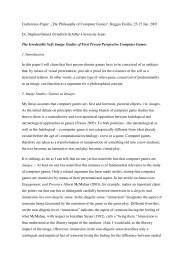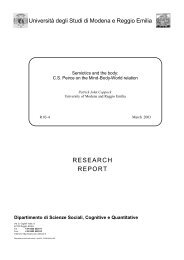Playing Dress-Up: Costumes, roleplay and imagination
Playing Dress-Up: Costumes, roleplay and imagination
Playing Dress-Up: Costumes, roleplay and imagination
You also want an ePaper? Increase the reach of your titles
YUMPU automatically turns print PDFs into web optimized ePapers that Google loves.
<strong>Playing</strong> <strong>Dress</strong>-<strong>Up</strong> Ludica<br />
Figure 11: A Dragon Rider (left) <strong>and</strong> assorted costumers (center) <strong>and</strong> a fairy (right) at The Labyrinth Of Jareth<br />
Fantasy Masquerade Ball, Los Angeles, 2006. (Images: Morie)<br />
Historic reenactments are of particular interest because they provide some useful insights into the ways in<br />
which men <strong>and</strong> women construe dress-up. In an attempt to unpack these differences, textile <strong>and</strong> fashion<br />
researcher Kimberly Miller conducted an ethnographic study of reenactment practices, combing<br />
qualitative <strong>and</strong> quantitative methods. (1998) In her study of adult costume play, she formulated a theory<br />
from the perspective of symbolic interactionism, which states that the self is established through<br />
communication. (Miller 1998) Referencing its originator, Mead (1934), as well as Goffman (1959) <strong>and</strong><br />
Blumer (1969), who developed his ideas further, Miller posits two theoretical frameworks for<br />
underst<strong>and</strong>ing dress-up play. The first is Eicher’s theory of dress as a communication of the self, <strong>and</strong> the<br />
concept of the “three selves” that are expressed through dress: Public—ones presentation in public sphere;<br />
Private—when engaged with family <strong>and</strong> friends; <strong>and</strong> Secret—when by oneself, when the bulk of fantasy<br />
play takes place. (1981) Miller combines this with Stone’s notion of “fantastic socialization,” (1965) the<br />
playing of roles that can never be realized in reality (as opposed to “anticipatory socialization,” the<br />
playing of fantasy roles in preparation for real-life situations.) The result is a hybrid model of what could<br />
be describe as “the three selves of fantastic socialization”: Public, costumes worn in a public context, such<br />
as a festival or holiday which are not anonymous; Private, costumes worn among friends or in the context<br />
of family/childhood play; Secret, which could include both activities that are solitary or intimate (such as<br />
sex play) <strong>and</strong> those which are public <strong>and</strong> anonymous. (Miller 1998) Games would appear to blend the<br />
first category with the third, as they provide an avenue to bring the private self into a public arena.<br />
Figure 12: Denizens of American Renaissance Faires sporting a variety of elaborate costumes. Note the small child<br />
with the kilted man at right. (Image: Nicole Fullerton; Courtesy of Pendragon <strong>Costumes</strong>)<br />
Philosophy of Computer Games 2007 Page 12






